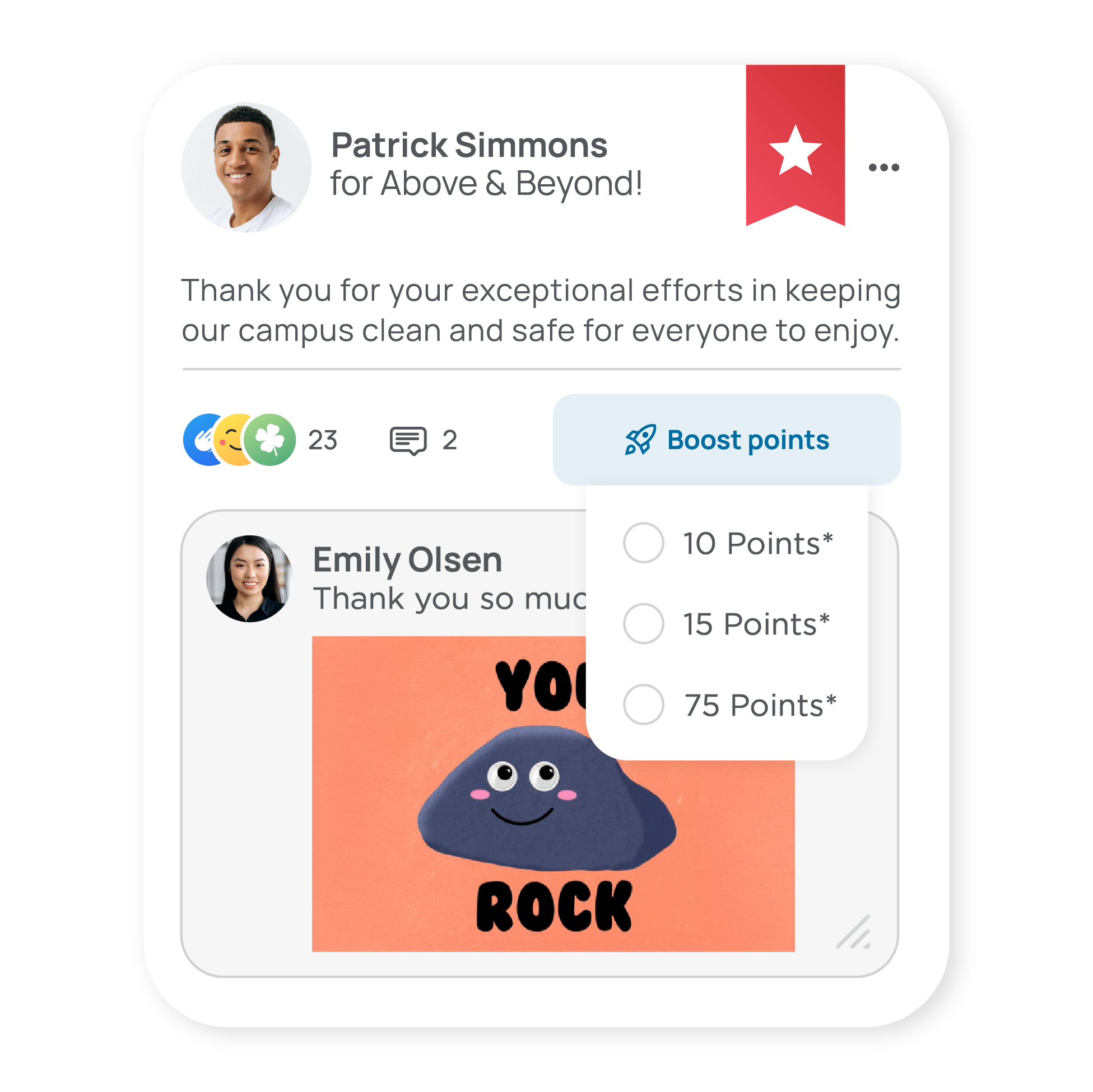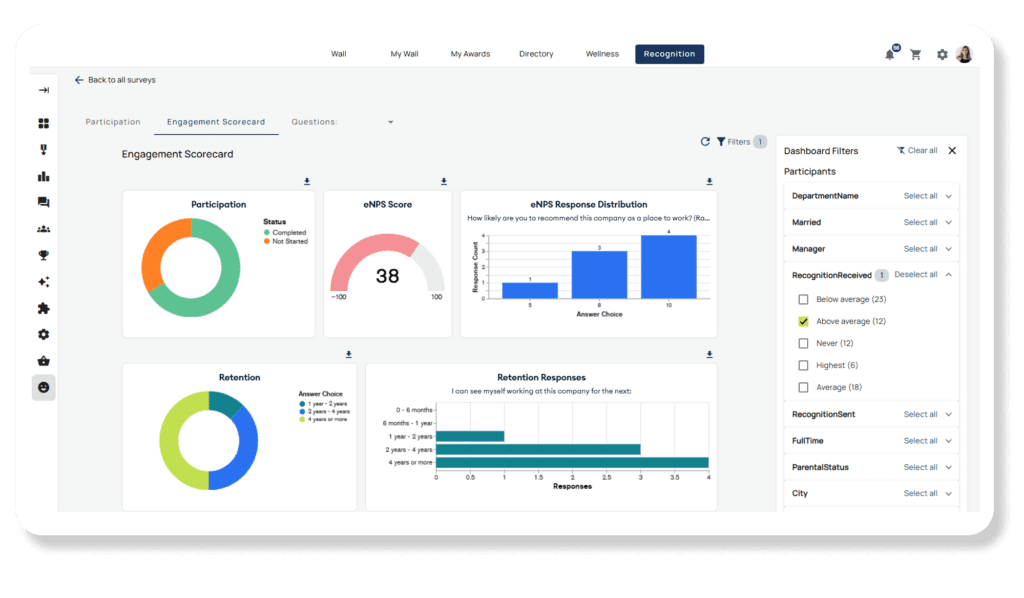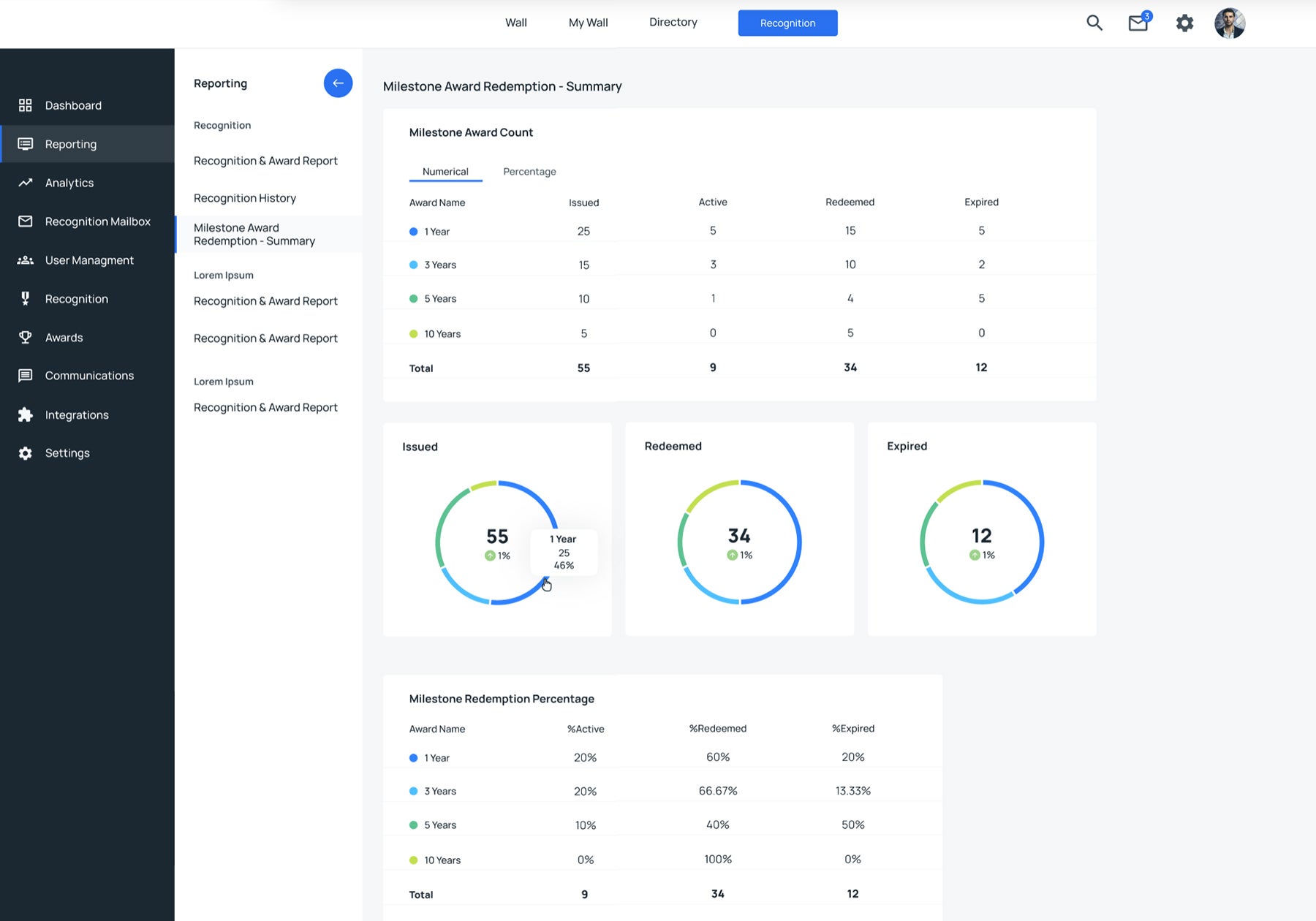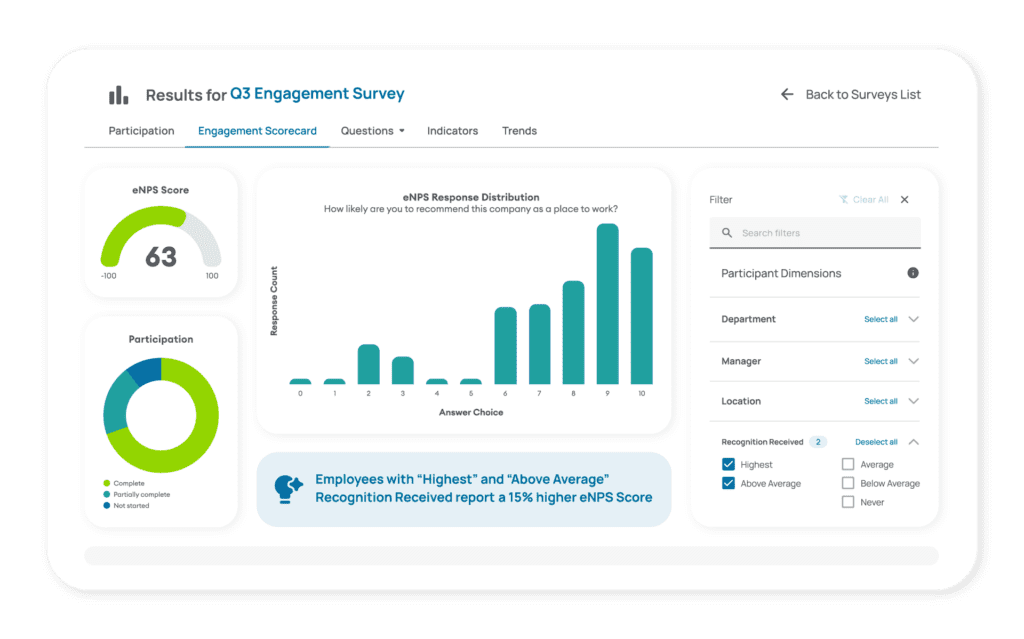June 30, 2025

Most online guides on reducing employee turnover take a one-size-fits-all approach to retention. They list the common causes for employee turnover and offer high-level advice on how to tackle each problem. For example, they end up advising you to “review your compensation policies” or “prioritize work-life balance” for your staff.
There are two big problems with this approach:
- Analyzing the common causes of employee turnover doesn’t reveal why your employees leave. Research bodies survey people across different companies and compile the most common reasons for people leaving their jobs. While it’s useful to know these factors, the data doesn’t reflect the sentiments of your workforce specifically. For example, “pay/benefits” being the most commonly cited reason for turnover doesn’t mean pay structures are a problem in your company.
- It neglects the nuance involved in people’s decisions to leave. It’s uncommon for one or two factors to be the primary culprits of turnover across an entire organization. People leave for lots of different reasons—maybe three people in one department weren’t happy with their manager, and two top performers from another team left because they didn’t see any room to grow their careers.
We created this guide to help you overcome these limitations by designing a retention strategy specific to your company’s needs. Here’s what this guide covers:
- How to accurately forecast employee turnover before the shoe drops. Our science-backed culture model lets you measure the factors contributing to employee churn in your organization, and the ones motivating people to stay.
- How to reduce employee turnover with our actionable framework. Forget about those generic “X common causes of turnover” and “X retention strategies to consider” lists. You can discover how to diagnose the causes of turnover in your organization, take action with engagement programs tailored to your strategic objectives, and prove your retention strategy’s impact.
- The benefits of executing our framework using an integrated employee engagement program. Get a complete picture of employee turnover in your organization with deep, centralized analytics.
What Causes Employee Turnover? 6 Science-Backed Retention Factors to Consider
We mentioned why relying on national survey data isn’t helpful for retention strategies—the data doesn’t reflect the state of turnover in your organization. But let’s scrutinize some of this survey data for a moment, to better understand its more nuanced limitations.
Gallup’s employee retention and attraction survey reveals the “primary” reasons that U.S. job seekers stated for leaving in the years 2020–2024:
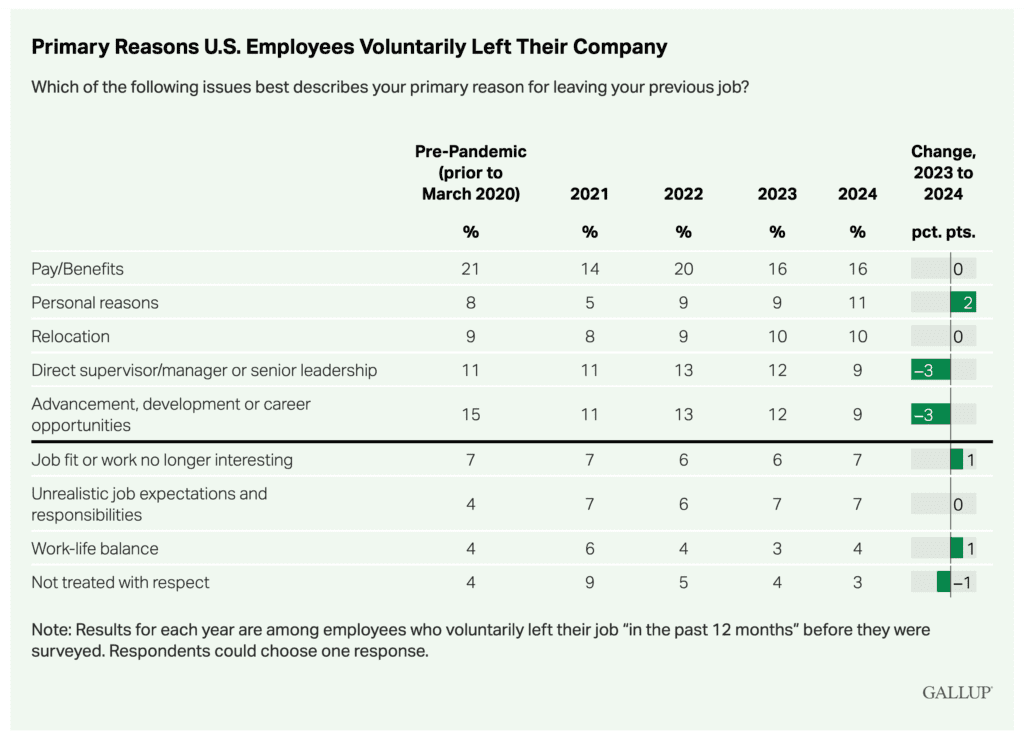
Source: Gallup's Employee Retention & Attraction Survey
The term “primary reason” here reflects two other limitations of national survey data. First, the questioning method compels employees to identify a single reason for leaving, neglecting any secondary reasons. Second, it relies on self-reporting, which isn’t always accurate. These reasons also don’t reflect the underlying motivations and the circumstances impacting an employee’s decision to leave.
For example, what does “work-life” balance here really tell you? Maybe twenty respondents selected it because they were handed responsibilities they didn’t feel prepared for. Perhaps another twenty had managers who poorly managed and distributed work across their teams. Without understanding this context, crafting an effective retention strategy remains elusive.
Our research and decades of experience in helping companies drive employee engagement have made us sure of one fact: there’s almost never a single factor to blame for an organization’s employee turnover. And although people might state similar reasons for staying or leaving, their decisions are influenced by a complex mix of factors (some more dominant than others).
Some people quit high-paying corporate jobs because of the freer hand they’re promised at a startup. Others might have an okay-ish relationship with their manager, but they stay because of the strong bond with their peers. Some factors are outside your control.
We set out to understand the factors within your control that influence employee engagement and retention, and to quantify their impact. With the help of three independent PhD researchers, we developed a culture model that forecasts and measures engagement and retention using six factors.

Known as engagement indicators, these six factors are:
- Purpose: Purpose indicates how well employees feel their goals and values align with your organization’s. This alignment is linked to significantly higher retention.
- Empowerment: Refers to employees having the resources, authority, and support they need to excel in their roles.
- Well-being: Measures the physical, mental, and emotional well-being of your workforce.
- Belonging: Refers to how integrated people feel in your company’s culture. People who feel a sense of belonging are more motivated at work, and collaboration comes easily to them.
- Leadership: How people feel about your company’s leadership directly impacts retention and engagement.
- Equity: Employees who feel recognized and have opportunities to be promoted are more motivated and likely to stay.
The culture model won’t help you bring employee turnover down to zero. But it does give organizations a blueprint to understand employees’ sentiments towards their jobs and the company’s culture.
The principle is simple: to reduce turnover, create a workplace culture that makes people want to stay.
A culture that keeps employees connected to your strategic objectives, prioritizes their well-being, supports their work, and helps them grow.
How to Reduce Employee Turnover with Strategic Employee Engagement Programs
We’ve helped thousands of companies improve employee engagement and retention using our “listen, measure, act, and optimize” framework. The framework uncovers the factors impacting employee retention and attrition in your organization and helps you take action with engagement programs tied to your core objectives.
1. Diagnosing the Causes of Turnover in Your Organization
Organizations commonly use three types of surveys to investigate employee turnover:
- eNPS (Employee Net Promoter Score) surveys: Most companies use eNPS as their north star for measuring employee retention and loyalty. Employees are typically asked a single question: "How likely are you to recommend this company as a great place to work?” on a scale of 1-10.
- Stay surveys: They’re a type of employee satisfaction survey used to collect feedback about your current employees’ overall job satisfaction and experiences with your organization.
- Exit surveys: These questionnaires collect feedback from employees who are leaving your company to help you understand their reasons and motivations for leaving.
These are useful, but the issues with limiting yourself to these types of surveys are:
- You’re compelled to take a reactive approach to retention. Exit surveys tell you that X number of people left for Y reason. The problem is you’ve already lost those people.
- They don’t give you the right actionable insights. Exit and stay surveys tell you the reasons some people cited for staying and leaving, respectively. But you won’t know which other employees are susceptible to leaving—or who’s motivated to stay—for the same reasons. Similarly, while eNPS surveys indicate who’s a churn risk, they don’t reveal why those employees might leave, or how you can encourage them to stay.
This is where the culture model comes into play. Monitoring the six engagement indicators and combining the insights with eNPS scores can help you proactively tackle churn. Instead of, say, finding out someone left because of a poor relationship with their manager, you can detect their sentiment beforehand and address it.
Our engagement survey, developed by three PhD researchers and backed by I/O psychologists, uses 38 questions to measure engagement across the six key indicators. For example, the question “My direct supervisor gives encouragement and recognition to staff” is one of seven that measure leadership.
The baseline survey measures and quantifies the factors impacting your workforce’s engagement and retention, both positively and negatively. It tracks how people feel about their leaders, their overall sense of well-being, how integrated they are with your company culture, and more.
After running the survey, you’ll have a set of Likert scores (which can be positive or negative) corresponding to each indicator. For example, you might score +20 in equity but -3 in leadership, indicating that certain cohorts don’t feel positively about their leaders.
Now, combining these scores with eNPS scores gives you a detailed picture of the cohorts most likely to churn, and why. For example, maybe:
- Your finance department scores low in eNPS, purpose, and belonging, but high in well-being, leadership, equity, and empowerment. This indicates that people in your finance department don’t feel connected to your organization’s broader culture and goals.
- Female employees aged 24–35 score low in equity and eNPS. This indicates that employees in this segment don’t feel they have opportunities to be promoted.
The combined insights from the baseline, eNPS, exit, and stay surveys give you a broad view of your organization’s employee turnover. You’ll understand the factors positively and negatively impacting retention.
The next step is to gather context around these factors—for example, why are some cohorts scoring low in leadership or equity? That’s where drill-down surveys are essential. The main ones to consider are:
- Employee engagement drill-down surveys: These six individual surveys are specific to each employee engagement indicator—purpose, empowerment, well-being, belonging, leadership, and equity.
- Employee satisfaction surveys: These surveys help you capture how people feel about specific initiatives, scenarios, people, policies, and your organization’s broader culture. For example, you could run a manager satisfaction survey, or an onboarding satisfaction survey for new hires.
You don’t need to limit yourself to additional surveys for this context. Sometimes, talking to some employees 1:1 or collecting feedback directly from managers can also give you a clearer picture of people’s sentiments.
2. Taking Action with Tailored Engagement Programs
Once you’ve got a clearer picture of the factors impacting retention in your turnover, you might feel inclined to launch multiple programs to address all the gaps. But you don’t have to solve all your turnover challenges the first time around. In fact, it’s often best to get started with just one engagement program.
Depending on your findings from employee listening, you might choose to start with:
1. An organization-wide engagement program, such as recognition.
Companies usually launch organization-wide programs after identifying gaps in their culture that impact the entire workforce, or when they want to enact positive changes across the board.
For example, many companies we’ve worked with launched company-wide engagement programs after their operations expanded to different locations. Their employee listening programs revealed workers were disconnected from the company’s culture and core values. So they launched programs to cultivate core values and a shared sense of purpose.
2. A smaller, tailored program targeting a specific cohort's needs.
Let’s say your employee listening program revealed a particular cohort of employees with low eNPS scores, and other surveys (baseline, employee satisfaction, etc.) reveal the factors that may prompt them to leave. For example, maybe they score low in equity, leadership, and eNPS.
In this case, you might launch a tailored program to address their needs. Starting small makes sense when (1) your listening program reveals specific groups that are high churn risks, and (2) you want to secure leadership buy-in before ramping up.
Regardless of the approach you take, there are four fundamental considerations for making your engagement program successful:
Consideration #1: Align your engagement program with strategic objectives and/or core values
The prospect of launching a generic employee engagement program and hoping for the best can be tempting. But in our experience, this approach rarely works out (if ever). Programs are successful when they’re tailored to specific goals.
For example, let’s say your employee listening program reveals that top performers score lower in “purpose,” “well-being,” and “empowerment” a month after being promoted. Your surveys reveal that top performers’ eNPS scores have also dropped.
The gap here is in how people are promoted, and a career development program is the engagement program of choice to address it. But if your goal is to improve retention—not just check off “career development program” as an action item—then you’ll need to consider:
- How to balance fulfilling company goals and making sure your top performers stay passionate about their work. Here, leaders may need to directly engage with their top performers to better understand their motivations, passions, and fears before designing these paths. They can use these learnings to create tailored career pathways.
- How to support people when they’re promoted. If your top performers are scoring lower on “empowerment,” it indicates they don’t feel supported in their new role. Addressing this means reevaluating the circumstances around promoting someone, such as the training they receive before assuming new responsibilities.
Consideration #2: Ensure leadership helps drive these programs
The most successful engagement programs have leaders—whether managers or senior executives—involved in some capacity. Leaders aren’t just sitting on the sidelines, signing off on budgets and managing approvals. They’re leading by example and demonstrating the program’s importance to your workforce, such as by:
- Being involved in recognition moments. Most successful recognition programs involve leadership in some way; managers handing out awards, celebrating employees’ contributions, and top performers being invited to dinners or exclusive meetings with senior executives.
- Participating in wellness programs, to reinforce their importance and encourage others to join in.
Getting leadership involved requires securing their buy-in first, which is why it’s important to design your programs with data and strategic objectives.
Consideration #3: Maximize participation
Your engagement program won’t have a chance to deliver if participation numbers are low, which is why maximizing participation is key. There are two parts to it:
- Motivate people: The most important consideration here is making sure the engagement program is relevant to your employees’ needs and company objectives. So long as that’s taken care of, you can focus on the next key motivating factor—choosing the right incentives. Selecting the “best” incentives usually comes down to:
- The type of program: For example, custom awards such as trophies and personalized jewelry are popular choices for a service awards program. But fitness trackers, a spa voucher, or a standing desk might make more sense for your wellness program.
- The recipient’s preferences: It’s challenging to satisfy every employee’s preferences with your program’s incentives, but a points-based rewards system can help. Employee rewards platforms offer these systems, where you can allocate points that employees can redeem for gifts of their choosing. Rewards platforms typically offer extensive catalogues with various rewards categories, ranging from electronics to lifestyle and travel rewards.
- Remove barriers: Does your wellness program’s activity challenge support people who move in different ways? Does your recognition program cater to both your desk and non-desk workers? If you’ve got the right program and the right incentives, make sure there aren’t any barriers making it difficult for specific employees to participate.
Consideration #4: Measurement and continuous improvement
Engagement programs are rarely 100% perfect on the first launch. In the next section, we explain how to measure their performance and impact and how to bridge any gaps you identify.
Other than these fundamentals, there generally aren’t any fixed rules for customizing your engagement programs. But some types of programs are better suited than others, depending on your needs. For example:
- Recognition programs are versatile and widely used for driving cultural change, such as instilling core values, strengthening people’s relationships with their managers, and celebrating people’s contributions and achievements. Years of service, employee of the month, and peer recognition are all types of recognition programs.
- Wellness programs are effective for helping employees with their physical, emotional, and mental well-being. Wellness programs range from challenges that motivate people to get more steps in or sleep better at night, to expert-led seminars and training to help people manage work-life balance.
- Employee listening programs ensure employees have a voice. They help you measure engagement, understand how people feel about their managers, colleagues, and new initiatives, etc.
- Learning and development programs help you address people’s feelings of empowerment and equity. They’re about supporting people in the work they do and preparing them for promotions. L&D programs aren’t just about courses and certifications; they’re also about developing career pathways for your teams and helping them achieve career goals.
Here’s a closer look at how you can tailor engagement programs to meet strategic objectives.
Case Studies: How Tailored Recognition Programs Drive Cultural Change Across Distributed Teams
Here, we’re going to talk about two companies we’ve worked with that solved similar problems by approaching recognition differently. These companies are Chelsea Groton Bank, the largest mutual bank in Eastern Connecticut, and Amteck, a large family-owned construction company.
Here’s the problem both companies faced: As their workforce grew and operations expanded across different locations, maintaining their strong culture became more challenging. Both companies struggled to keep their growing, distributed workforces connected to the companies’ core values.
Their solution? Amteck and Chelsea Groton Bank realized that employee recognition programs, tied to the company’s core values, were the best way to cultivate their culture. But while Amteck chose to invest in a service awards program, Chelsea Groton Bank used a peer recognition program. Here’s what they did:
Amteck’s Service Awards Program
With Terryberry’s help, Amteck revived and updated its old legacy rings program. The updated program recognizes employees’ contributions and celebrates years of service milestones.
We manufactured custom rings for the program, with embedded stones indicating each employee’s years of service. Each recognition moment is linked to the employees’ unique contributions and celebrates them for demonstrating the company’s core values. Amteck’s leadership personally distributes the rings, and the recognition moments are documented with videos and photos that are shared in an internal company newsletter.
The result? Amteck observed a 65% increase in employees articulating core values within 3 months. The construction company also boasts an 85% retention rate among employees with over 10 years of service.
Chelsea Groton Bank’s Peer Recognition Program
We helped Chelsea Groton Bank launch a custom peer recognition program, where employees can nominate each other for demonstrating one of the company’s seven core values: being innovative, collaborative, trustworthy, professional, knowledgeable, versatile, and positive.
The program, called Acorn Rewards, includes different recognition levels and rewards. After collecting 10 Purple Acorns, an employee receives a custom plush toy called a “Happy Squirrel”.
For every additional 10 Purple Acorns they collect, they receive points which can be redeemed for luxury and lifestyle rewards. Employees who receive the highest level of recognition in the program—the Mighty Oak Award—are invited to attend a senior team meeting, where they’re recognized in front of their manager and senior leaders.
The result? Chelsea Groton’s Acorn Rewards program currently boasts a participation rate that’s more than double the industry average for financial organizations.
Both Amteck and Chelsea Groton succeeded in using recognition programs to cultivate their core values. Although they designed their programs differently, they followed the fundamentals of a successful engagement program.
They tied their programs to core values and objectives, motivated employees to participate with the right rewards, and engaged leadership to drive the program.
3. Measuring Impact and Updating Your Program(s)
Measuring your program’s performance and impact shows you what’s working and where you can improve. You’ll get the clearest picture of your program’s impact by combining three sets of data:
- Participation metrics, including the number of participants, manager and employee participation, and program-specific insights (e.g., for a recognition program, who are your most and least recognized employees?). You can usually access these metrics in-platform if you’re using software to host your engagement program, like employee recognition software or an employee learning management system (LMS).
- Employee listening data, especially eNPS and engagement indicator scores. There are several types of surveys and questions you can use to gauge your program’s impact. For example, one of our customers asked workers to recall the company’s core values before and after launching a service awards program. These kinds of questions do measure the program’s impact. But you’ll need eNPS and engagement indicator scores for more granular insights into its impact on retention.
- Broader HR metrics, including absenteeism, voluntary turnover, and your retention rate. Any changes in these metrics, before and after your program was launched, give a broad picture of your program’s organization-wide impact.
HR metrics like employee turnover are useful for benchmarking—you can compare yours to industry averages. You can also use your turnover rate to estimate the ROI of launching an employee engagement program. For more granular insights, though, you’ll need to combine participation metrics with listening data.
Here are the kinds of insights you can capture:
If you’re running a manager recognition program, you can measure:
- The eNPS scores of teams with managers who participate a lot in the program, vs. those who don’t.
- Changes in engagement indicator scores for your most recognized employees. Are indicators such as “leadership” and “purpose” increasing? Are any indicators decreasing?
- Trends across different cohorts. Are some groups of employees (a specific generation, gender, or department) getting the least recognition? How is this impacting their engagement scores and eNPS?
If you’ve launched a wellness program, you can measure:
- The eNPS and employee well-being scores of participants over time.
- Any trends, such as the well-being scores of people who participate the most vs. the least in the program.
- How your wellness program impacts recognition, and vice versa. For example:
- Since your wellness program went live, have employees been more engaged at work? Are peers recognizing each other more often in your peer recognition program?
- Are there any negative trends? For example, are your most recognized employees not participating in your wellness program? That could indicate burnout.
These insights reveal your program’s successes and any gaps, which you can address by tweaking it or launching smaller, tailored programs. Here are some scenarios where you can take different courses of action depending on your findings:
Scenario #1
You’ve been running a recognition program for six months, and recent employee listening data shows that the well-being and purpose scores for your most recognized employees have dropped since the program’s launch.
So you investigate further, using drill-down surveys and talking to the segment’s managers. You discover that their roles and responsibilities have evolved, and they’re less passionate about what they do now. They’re feeling drained and disconnected from your company’s goals as a consequence.
Courses of Action to Consider
- Reassessing the responsibilities of employees in this cohort, striking a balance between each person’s passions and interests while making sure their roles are aligned with company goals.
- Launching a targeted wellness initiative to boost this group’s well-being. Maybe you schedule an expert-led training session with guidelines for helping employees maintain work-life balance.
- Reevaluating your company’s learning and development program, or launching one if you haven’t already. The program should facilitate leaders in designing career development pathways for their employees, accounting for each employee’s ambitions and interests without compromising on company goals.
Scenario #2
You’ve been running a wellness program for a month, which includes a step activity challenge and expert-led seminars. While employees of all ages attend the seminars, your participation numbers for employees aged 40 and above are particularly low.
Courses of Action to Consider
Use employee listening to understand why participation is low in this cohort.
Gather insights through follow-up surveys, 1:1 conversations, and manager feedback. Common barriers might include:
- The activity challenges feel too physically demanding.
- They don’t have time to participate due to non-work responsibilities.
- They feel discouraged if they can’t keep up with younger employees.
Based on what you learn, consider the following:
- Launching a small, tailored activity program for this specific cohort. You could design challenges that match their physical abilities and personal responsibilities.
- Reevaluating your existing program for inclusivity and equity. For example, offer an activity converter that lets participants choose how they move within the program.
Design, Launch & Scale Your Retention Strategy with Terryberry’s Employee Engagement Platform
Although several types of employee retention tools can help you fight turnover, there are two main benefits of using an integrated platform like Terryberry’s:
- There’s less admin work. You’re only managing one vendor relationship, subscription, and set of access levels.
- Centralized data gives you an edge. Terryberry is the only employee engagement platform that lets you measure how employee listening, recognition, and wellness programs impact each other.
Terryberry’s centralized employee engagement platform lets you develop and execute an end-to-end employee retention strategy. Diagnose the causes of employee attrition in your organization, take action with tailored engagement programs, and build your business case with deep, centralized analytics. Here’s how it works.
1. Use Pre-Designed Surveys to Uncover Root Causes of Employee Turnover
Terryberry’s survey library makes it easy to hit the ground running. Choose from dozens of different survey types, from burnout surveys to scenario-specific ones regarding disaster response. If you’re investigating employee turnover, then our engagement baseline survey is a good place to start. It uses 38 questions to assess employees across the six engagement indicators, giving you a set of scores corresponding to each. Combining these scores with eNPS will show you the dominant factors impacting retention.
Terryberry’s survey analytics (shown above) benchmark your eNPS surveys against similar companies, based on size, industry, and both. You can use the participant filters to uncover trends in your data, such as:
- Departmental trends: Are employees in some departments scoring higher or lower in eNPS or specific engagement indicators overall?
- Generational differences: Does your organization’s culture impact age groups differently? Is there a difference in the sense of equity or the empowerment of employees from different generations?
- Manager-specific insights: Which managers recognize employees the most? What are the eNPS scores of their teams? Which managers don’t participate in your recognition and wellness programs at all?
After uncovering relevant trends with the initial baseline and eNPS surveys, you can follow up with drill-down surveys for more context. For example, if you identify specific cohorts that score low in leadership and equity, you can run respective leadership and equity surveys to better understand why employees score low here.
2. Launch Tailored Employee Engagement Programs
Once you’ve uncovered the culprits of employee turnover, Terryberry’s engagement platform makes it easy to take action with tailored recognition and wellness programs. We set your program up for success by:
- Helping you tailor it to strategic objectives. Looking to promote your company’s core values across a distributed workforce? We’ll configure Terryberry’s platform around these values, customizing nominations, milestones, approvals, and rewards. Need to target specific gaps in your retention strategy, like low leadership scores? We’ll help tailor your program to cultivate manager-employee relationships.
- Motivating employees with the right incentives. We manufacture custom awards, offer our own Premium Rewards catalog, and have partnered with Amazon Business to bring you the most extensive rewards catalogue in the industry. Whether you need custom jewelry or plaques for a service awards program, or self-care and fitness rewards for your wellbeing program, we’ve got you covered.
- Eliminating barriers and ensuring equity. Does your team include non-desk workers? We’ll make sure they’re connected to the program. Have team members distributed across different countries? We’ll help you design a fair, equitable rewards experience.
3. Measure Impact and Build Your Business Case
Forget about the pain of combining disparate data across different engagement programs. Terryberry centralizes the data across your employee listening, recognition, and wellness programs in one place, so you can measure how these programs impact each other.
Remember how we discussed combining participation stats with employee listening data to measure your program’s impact on retention? Terryberry combines, organizes, and interprets these different data sets for you. For example, here’s a snapshot of our Recognition Analytics:
And here are the analytics from the engagement indicators dashboard:
Combining these data sets can help you understand:
- The impact of your recognition program on specific engagement indicators. For example, is your manager recognition program increasing leadership scores? Is your peer recognition program increasing a sense of belonging and equity? And how are these changes ultimately impacting eNPS scores?
- Gaps in your program that need addressing. Is recognition positively impacting some cohorts more than others? Which engagement indicators are changing over time?
Ready to reduce employee turnover with a science-backed, actionable framework? Schedule a demo with our team to drive retention with tailored employee engagement programs.

